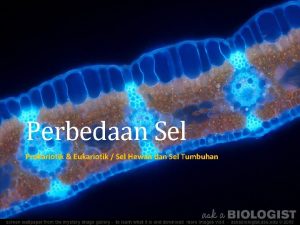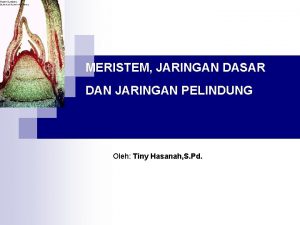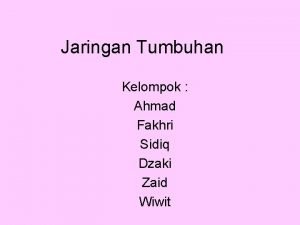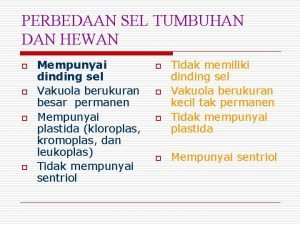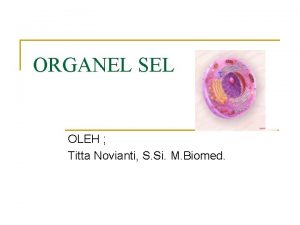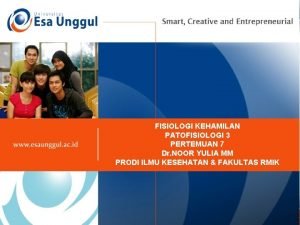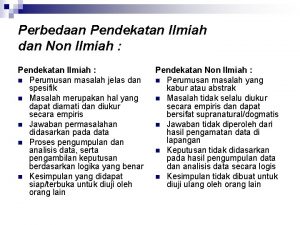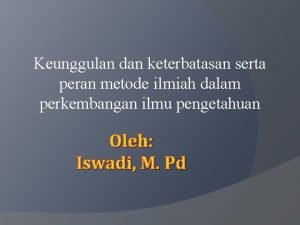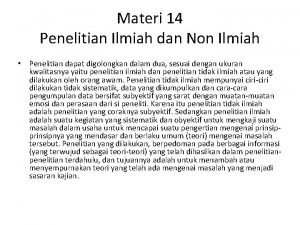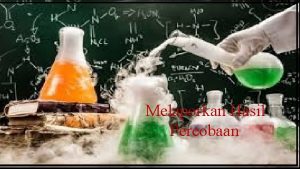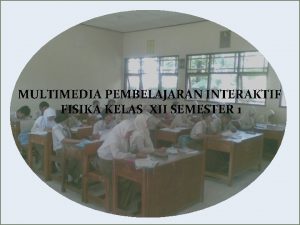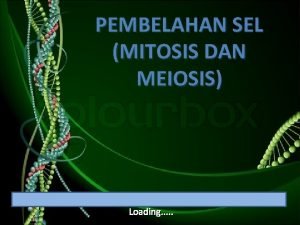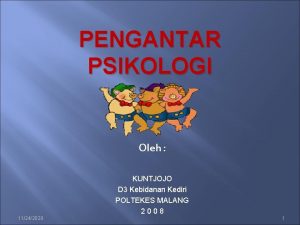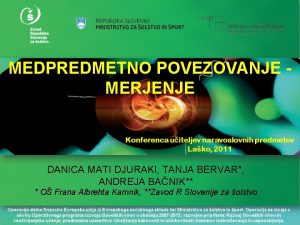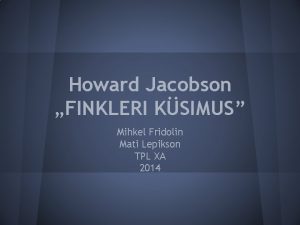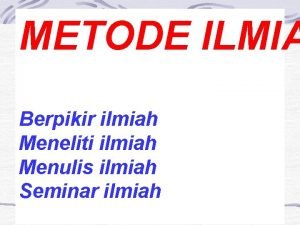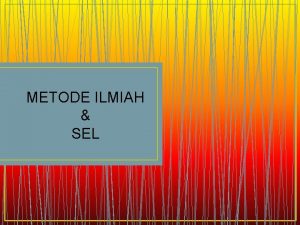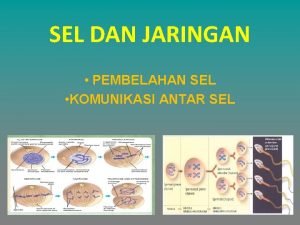Secara ilmiah dapat dinyatakan ada sel yang mati








































- Slides: 40

Secara ilmiah dapat dinyatakan ada sel yang mati (nekrosis atau apoptosis) dan sel yang hidup (normal atau tumor/kanker) berberdasarkan gejala/fenomena - nya. Sebutkan 3 gejala sel yang hidup dan jelaskan uraian keterkaitannya dengan berfungsinya gen (DNA-

SETIAP SEL TANAMAN DAN SEL MAMALIA BERSIFAT TOTIPOTEN. • Dari setiap sel tanaman (dari akar, daun dll) dapat ditumbuhkan (dikulturkan) menjadi tanaman seutuhnya yang identik, • Namun dari sel hewan tidak dapat sedemikian, • Hanya saja dengan penemuan teknologi kloning domba “dolly” yang identik dengan induknya dapat dibuktikan totipotensi sel hewan (mamalia). SESUAI DENGAN DIFINISI TOTIPOTEN, JELASKAN BAGAIMANA TEKNOLOGI KLONING DOMBA DAPAT MEMBUKTIKAN TOTIPOTENSI SEL HEWAN 1. TOTIPOTENT 2. PLURIPOTENT ? ? ? The inner cell mass cells can form virtually every type of cell found in the human body, they cannot form an organism. Therefore, these cells are referred to as pluripotent, that is, they can give rise to many types of cells but not a whole organism 3. MULTIPOTENT ? ? ? Pluripotent stem cells undergo further specialization into stem cells that are committed to give rise to cells that have a particular function. These more specialized stem cells are called multipotent—capable of giving rise to several kinds of cells,

STRUKTUR MEMBRAN PLASMA SEL DAPAT DIJELASKAN DENGAN MODEL “FLUID MOZAIC”. (a) Jelaskan pengertian tersebut, serta (b) Tunjukkan adanya empat jenis (type) protein sesuai posisinya pada membran plasma dalam gambar skematik. (c) Sebutkan dengan sedikit penjelasan 4 jenis protein pada membran plasma sesuai fungsinya (d) Protein yang menghubungan dengan sel tetangganya atau biomatriks diluar sel, adalah integrine, cadherin, cam (cell adhesive molecul), coba jelaskan dengan skematik bedanya

Vincristrin sebagai obat dari tanaman untuk terapi tumor dengan mekanisme merubah atau menghambat konformasi (bentuk) mikrotubuli. Mikrotubulin (dan atau mikrofilament) berupa struktur gabungan (polimer) tersusun dari banyak unit protein monomer 1. Apa fungsi mikrotobuli yang dihambat/ diganggu oleh vincristin. 2. Sebutkan 1 fungsi mikrotobuli yang lain.

1. Phagosome 2. Lysosome 3. Peroxysome 4. Proteasome Merupakan organela sel dengan fungsi mencernakan materi yang tidak diperlukan oleh sel atau diproses selanjutnya. Diantara 4 “some” tersebut ada perbedaan pembentukan dan fungsinya, jelaskan !

Lysosomes are the cells' garbage disposal system. They degrade the products of injestion, such as the bacterium that has been taken in by phagocytosis Lysosomes also degrade worn out organelles such as mitochondria. A third function for lysosomes is to handle the products of receptormediated endocytosis such as the receptor, ligand associated membrane Peroxisomes are organelles that contain oxidative enzymes, They are self replicating, like the mitochondria.

Bakteri patogen yang dikenal asing oleh “macrophage” kemudian di proses untuk akhirnya gugus antigen bakteri dipresentasikan di luar selnya sehingga proses respon imun dapat berlanjut ( ke limfosit-T) Sebutkan dan jelaskan dua proses biologik yang terjadi dengan menyebutkan berbagai organela sel yang terlibat





B A Limfosit-T membunuh sel tumor dengan cara berbeda dari Macrophage Sebutkan dan jelaskan dua proses biologis beserta organela sel dan molekul yang terlibat dalam proses sehingga sampai sel tumor dapat mati

KADAR LDL (KOLESTEROL) DALAM DARAH YANG TINGGI BOLEH JADI DISEBABKAN ADA GANGGUAN PADA PROSES BIOLOGIS “RECEPTOR MEDIATED ENDOCYTOSIS” 1. JELASKAN PEMIKIRAN TERSEBUT 2. JELASKAN PULA PEMIKIRAN IDENTIK TERSEBUT YANG TERJADI PADA VIRUS

EKSOSITOSIS -> SEKRESI

ENDOSITOSIS

RECEPTOR MEDIATED ENDOSITOSIS - HORMON AND GROWTH FACTOR - SERUM TRANSPORT PROTEIN ( LDL = Low Density Lipoprotein ) - ANTIBODY - VIRUS - TOKXINS AND LECTINS





PALING SEDIKIT ADA DUA PROSES BIOLOGIS PENTING SEHINGGA DAPAT DIJELASKAN BAGAIMANA SPERMA DAPAT MENEMBUS LAPISAN OVUM SEBELUM TERJADI FERTILISASI JELASKAN !

Sel tumor/kanker pada stadium lanjut dapat berpindah dan tumbuh (metastase) di tempat lain dalam tubuh manusia pada hal sel tsb. Tidak mempunyai alat bantu gerak (ekor atau rambut gerak) 1. Jelaskan proses/gejala biologis apa sehingga sel kanker dapat berpindah/bergerak 2. Jelaskan proses/gelaja biologis apa sehingga sel kanker hanya dapat metastase pada organ atau jaringan tertentu.

RIBOSOME SEBAGAI ORGANELA SEL TEMPAT DIMANA PROTEIN/PEPTIDA DIBUAT/DIBIOSINTESIS 1. APA FUNGSI SUSUNAN “POLYRIBOSOME”, JELASKAN ! 2. KLORAMFENIKOL SEBAGAI ANTIBIOTIKA MEMBUNUH BAKTERI DENGAN CARA MENGHAMBAT BIOSINTESIS PROTEIN, NAMUN BIOSINTESIS PROTEIN MANUSIA (PASIEN) TIDAK DIHAMBAT), JELASKAN FENOMENA TERSEBUT. Prokaryotic Ribosomes Eukaryotic Ribosomes

Suatu protein yang berada&berfungsi di membran plasma ( cell membrane) berasal dari pembuatan (di-biosintesis) di ribosom. (Protein biosintesis and their transport to the position) (a) Jelaskan perjalanan ( tahapan proses biologis dan beberapa organel sel lain yang berperan) protein tersebut dari ribosom ke membran plasma, demikian pula (b)bagaimana penjelasannya bahwa suatu protein posisi nya di membran plasma dan tidak di tempat/posisi yang lain









Nekrosis ? ? ? Apoptosis

Cell death occurs by 2 processes Necrosis and Apoptosis. Unprogrammed cell death, Necrosis, leads to the bursting of a cell and its contents being spilled into the extracellular space, followed by inflammation. Programmed cell death, or Apoptosis (a term first coined in 1972), is a series of regulated steps modification of cell membrane, DNA condensation and severing, cytoskeleton dissassembly, followed by "blebbing" cytoplasmic and nuclear contents into membrane bound fragments, engulfed by macrophages (phagocytosis). Cell Death is a field of research that has grown enormously in recent years. The growing interest is not only for its biological relevance in maintaining homeostasis in multicellular organisms, but also for its potential clinical application in regulating cell numbers (both up and down). The key concepts are: cell cycle, mitosis, meiosis, apoptosis, necrosis, signaling


The breast is one of the few organs that completes its development after birth in two discrete physiological states: puberty and pregnancy. During these stages there are noticeable alterations in breast proliferation and differentiation. Changes in the apoptotic regulatory proteins of the Bcl-2 family occur in part due to the influence of oestrogens and progesterone. Cells in the termini of the developing mammary ducts remain mitotically quiescent until the onset of pregnancy. Then rapid epithelial proliferation occurs, with additional ductal branching and lobuloalveolar growth. After lactation there is massive restructuring and apoptosis leading to involution and a return to the primary structure. In the absence of pregnancy there is repeated cycling of the resting state in parallel with menstruation until there follows a gradual process of senile involution with menopause. Most apoptotic changes occur in the lobular unit of the terminal duct, with cyclical changes through the menstrual cycle and a peak of apoptosis close to the end of the menstrual cycle. A peak of proliferation occurs a few days earlier. It is clear that a balance between proliferation, differentiation, and death of the cells throughout the mammary gland is critical for normal development and homoeostasis. Situations that can upregulate cell proliferation or downregulate apoptosis may allow accumulation of

Cell Death and Its Regulation In the preceding sections, we have described various extracellular signaling molecules, and their intracellular signaling pathways, that play a role in regulating cell division, pattern formation, differentiation, morphogenesis, and motility. In this final section, we consider signaling pathways regulating cell survival. Programmed cell death, a central mechanism controlling multicellular development, leads to deletion of entire structures (e. g. , the tail in developing human embryos), sculpts specific tissues by ablating fields of cells (e. g. , tissue between developing digits), and regulates the number of neurons in the nervous system. In the mammalian nervous system, for instance, the majority of cells generated during development also die during development. Cellular interactions regulate cell death in two fundamentally different ways. Most, if not all, cells in multicellular organisms require signals to stay alive. In the absence of such survival signals, frequently referred to as trophic factors, cells activate a "suicide" program. In some developmental contexts, including the immune system, specific signals induce a "murder" program that kills cells. Whether cells commit suicide for lack of survival signals or are murdered by killing signals from other cells, recent studies suggest that death is mediated by a common molecular pathway. In this final section, we first distinguish programmed

In the absence of such survival signals, frequently referred to as trophic factors, cells activate a "suicide" program.


 Tabel perbedaan sel tumbuhan dan sel hewan
Tabel perbedaan sel tumbuhan dan sel hewan Contoh karangan ilmiah semi ilmiah dan non ilmiah
Contoh karangan ilmiah semi ilmiah dan non ilmiah Gaya ada yang ... dan ada pula yang
Gaya ada yang ... dan ada pula yang Diketahui kurva yang dinyatakan secara implisit
Diketahui kurva yang dinyatakan secara implisit Notasi himpunan huruf vokal
Notasi himpunan huruf vokal Sel kipas
Sel kipas Sel mati
Sel mati Tidak memiliki membran inti sel
Tidak memiliki membran inti sel Kerja ilmiah yang dilandasi sikap ilmiah akan menghasilkan
Kerja ilmiah yang dilandasi sikap ilmiah akan menghasilkan Relasi antara dua himpunan dapat dinyatakan dengan cara
Relasi antara dua himpunan dapat dinyatakan dengan cara Perbandingan vektor dan koordinat
Perbandingan vektor dan koordinat Sel haiwan
Sel haiwan Perbezaan sel haiwan dan tumbuhan
Perbezaan sel haiwan dan tumbuhan Perbedaan sel tumbuhan dan sel hewan
Perbedaan sel tumbuhan dan sel hewan Peristiwa sel telur dibuahi oleh sel sperma disebut
Peristiwa sel telur dibuahi oleh sel sperma disebut Pendekatan ilmiah dan non ilmiah
Pendekatan ilmiah dan non ilmiah Contoh karya non ilmiah
Contoh karya non ilmiah Apa keterbatasan dan keunggulan metode ilmiah ?
Apa keterbatasan dan keunggulan metode ilmiah ? Etika penelitian
Etika penelitian Dalam laporan percobaan tidak ada urutan waktu tetapi ada
Dalam laporan percobaan tidak ada urutan waktu tetapi ada Nilai dari tabel kebenaran biimplikasi adalah
Nilai dari tabel kebenaran biimplikasi adalah Solat sunat muakkad
Solat sunat muakkad Notasi kalimat deskriptif
Notasi kalimat deskriptif Gelombang stasioner
Gelombang stasioner Ciri ciri anafase
Ciri ciri anafase Membangun teks artikel ilmiah secara bersama sama
Membangun teks artikel ilmiah secara bersama sama Dapatkah jiwa dipelajari secara ilmiah
Dapatkah jiwa dipelajari secara ilmiah Pengambilan keputusan secara ilmiah
Pengambilan keputusan secara ilmiah Format karya tulis ilmiah
Format karya tulis ilmiah Suatu pekerjaan dapat diselesaikan sel
Suatu pekerjaan dapat diselesaikan sel Peta konsep jaringan internet
Peta konsep jaringan internet Setiap kelompok atau tim
Setiap kelompok atau tim Pengertian gaya tarik
Pengertian gaya tarik Guru
Guru 1 moška sklanjatev
1 moška sklanjatev Notasi bukaan pintu
Notasi bukaan pintu Danica mati djuraki
Danica mati djuraki Mama je nedolžna
Mama je nedolžna Kesalahpahaman tentang allah tritunggal
Kesalahpahaman tentang allah tritunggal Mati lepikson
Mati lepikson Zevsova ljubica io
Zevsova ljubica io
